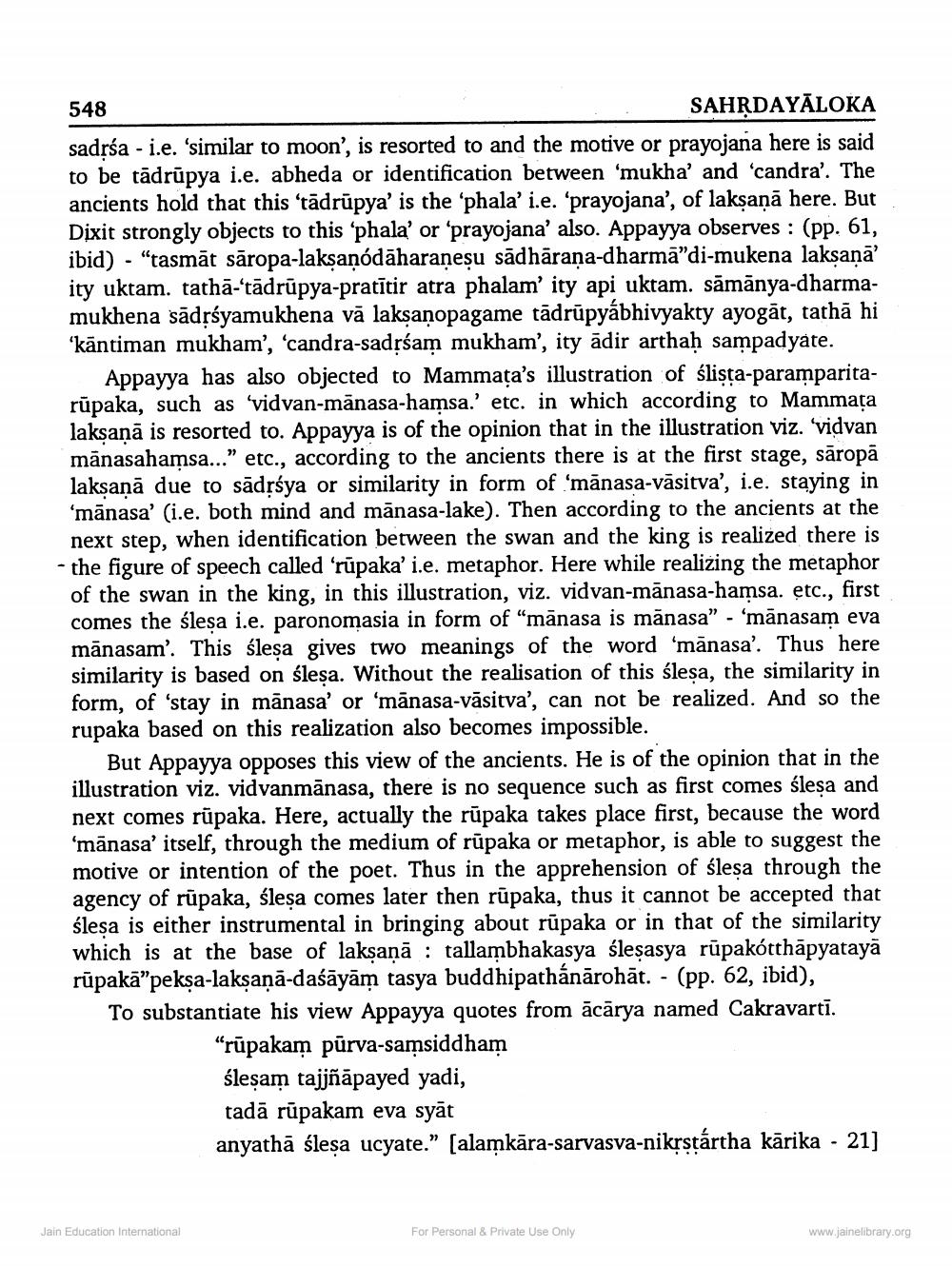________________
548
SAHRDAYĀLOKA
sadrśa - i.e. 'similar to moon', is resorted to and the motive or prayojana here is said to be tādrūpya i.e. abheda or identification between 'mukha' and 'candra'. The ancients hold that this tādrūpya' is the 'phala' i.e. 'prayojana', of laksaņā here. But Dixit strongly objects to this ‘phala' or 'prayojana' also. Appayya observes : (pp. 61, ibid) - "tasmāt sāropa-laksanódāharaneșu sādhārana-dharmā"di-mukena laksanā’ ity uktam. tathā-'tādrūpya-pratītir atra phalam’ity api uktam. sāmānya-dharmamukhena sādņśyamukhena vā laksanopagame tādrūpyábhivyakty ayogāt, tathā hi ‘kāntiman mukham', 'candra-sadịśam mukham', ity adir arthaḥ sampadyate.
Appayya has also objected to Mammața's illustration of ślista-paramparitarūpaka, such as 'vidvan-mānasa-hamsa.' etc. in which according to Mammata laksaņā is resorted to. Appayya is of the opinion that in the illustration viz. 'vidvan mānasahamsa...” etc., according to the ancients there is at the first stage, sāropā laksanā due to sādrśya or similarity in form of ‘mānasa-vāsitva', i.e. staying in ‘mānasa' (i.e. both mind and manasa-lake). Then according to the ancients at the
next step, when identification between the swan and the king is realized there is - the figure of speech called 'rūpaka' i.e. metaphor. Here while realizing the metaphor of the swan in the king, in this illustration, viz. vidvan-mānasa-hamsa. etc., first comes the ślesa i.e. paronomasia in form of “mānasa is mānasa” - ‘mānasam eva mānasam'. This śleșa gives two meanings of the word 'mānasa'. Thus here similarity is based on ślesa. Without the realisation of this slesa, the similarity in form, of 'stay in mānasa' or 'mānasa-vāsitva', can not be realized. And so the rupaka based on this realization also becomes impossible.
But Appayya opposes this view of the ancients. He is of the opinion that in the illustration viz. vidvanmānasa, there is no sequence such as first comes ślesa and next comes rūpaka. Here, actually the rūpaka takes place first, because the word ‘mānasa' itself, through the medium of rūpaka or metaphor, is able to suggest the motive or intention of the poet. Thus in the apprehension of ślesa through the agency of rūpaka, śleşa comes later then rūpaka, thus it cannot be accepted that ślesa is either instrumental in bringing about rūpaka or in that of the similarity which is at the base of laksaņā : tallambhakasya śleşasya rūpakotthāpyatayā rūpakā”peksa-laksaņā-daśāyām tasya buddhipathánārohāt. - (pp. 62, ibid), To substantiate his view Appayya quotes from ācārya named Cakravarti.
“rūpakam pūrva-samsiddham ślesam tajjñāpayed yadi, tadā rūpakam eva syāt anyathā śleșa ucyate.” (alamkāra-sarvasva-nikrstártha kārika - 21]
Jain Education International
For Personal & Private Use Only
www.jainelibrary.org




